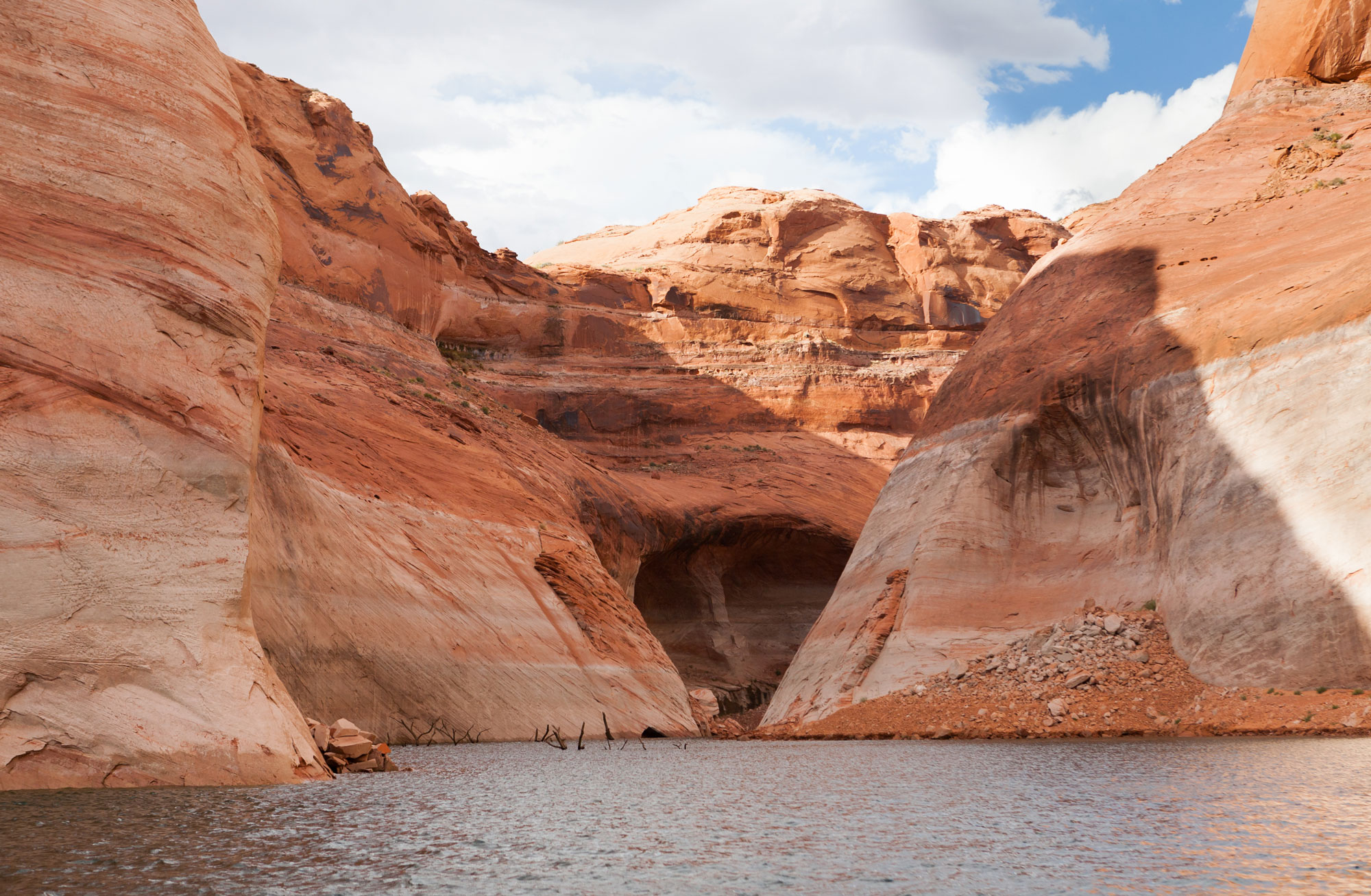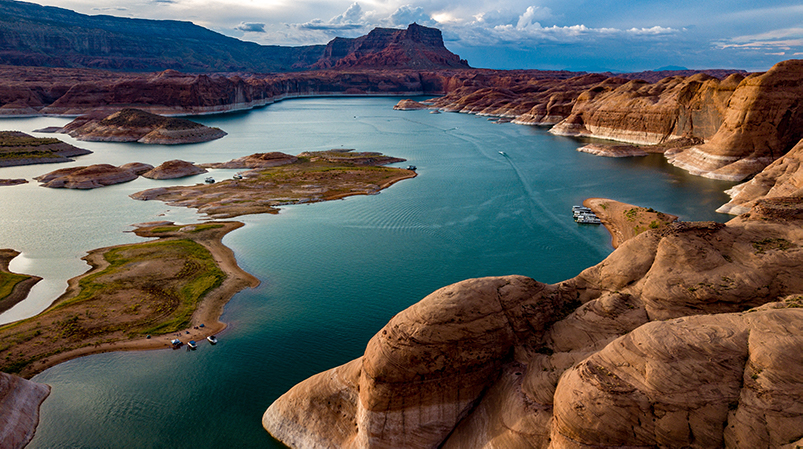As climate change and prolonged drought continue to impact Colorado River water supplies, the Colorado River Basin Interim Guidelines have been a crucial tool for guiding river management. The Colorado River Basin has been experiencing a historic megadrought the past 20 years; the amount of water actually flowing in the river is significantly less than throughout the 20th century when the Law of the River was developed. It’s clear that robust and resilient river management agreements are more important than ever.
The Interim Guidelines were developed in 2007 to respond to these changing conditions on the river. Interim Guidelines were a great first step in helping states and water resource managers adapt to the changing hydrology of the river, and work as a tool for planning against an increasingly unpredictable future. The Interim Guidelines help coordinate how much water is kept in or released from Lake Powell and Lake Mead, in order to balance the needs of communities relying on the Colorado River and other critical functions, like maintaining important hydroelectric power production. Interim Guidelines also map out how shortages will be implemented if reservoir levels and water supplies reach specified elevations, as well as facilitate state and federal cooperation in an effort to avoid that from happening.
However, the impacts of climate change and the continued aridification, or drying out, of our region has pushed water levels in the Colorado River to the point of the federal government announcing an official shortage declaration — the point at which specific states are required to use less water. These pressing challenges and the looming 2026 expiration of the Interim Guidelines mean that the time has come to update them to address the modern reality of the river.
Why Are There Colorado River Basin Interim Guidelines?
For a century, the Colorado River’s water has been divvied up and governed by the “Law of the River”, which is a collection of legal agreements, compacts, court decrees, international decisions, and congressional acts. The foundation of the Law of the River is the Colorado River Compact of 1922, which divided the Basin into the Upper and Lower Basins. Subsequent decisions dictate what share of the river the different states and water users, including Mexico, are entitled to throughout the Colorado River Basin. The fundamental challenge is that decision making in the past 100 years has overallocated the river, meaning there are more demands on the river each year than is physically available. This has become quite visible in the Gulf of California: Once Glen Canyon Dam was completed in 1963 and water began to be stored in Lake Powell, annual river flows to the Colorado River Delta have been greatly diminished or completely nonexistent, leading to devasting ecological impacts to the Colorado River Delta region. This over-allocation was baked into the original 1922 compact when the negotiators did not use the most accurate data on what the river could reasonably provide. Plus, we now know that the time period during which the Colorado River Compact was created was uncharacteristically wet for the Colorado River.
Colorado River Basin allocations were baked into the Colorado River Compact of 1922
The Colorado River is managed and operated under numerous compacts, federal laws, court decisions and decrees, contracts, and regulatory guidelines collectively known as the “Law of the River.

The Lower Colorado River Basin
The Boulder Canyon Project Act of 1928 apportioned the Lower Basin’s 7.5 MAF based on a fixed quantity of water. Each year the Lower Basin states receive the following amounts:
- Arizona = 2.8 MAF
- California = 4.4 MAF
- Nevada = 0.3 MAF
The Upper Colorado River Basin
In 1948, the Upper Colorado River Basin Compact created the Upper Colorado River Commission. It decided to apportion the Upper Basin’s 7.5 MAF, or the amount available in any given year, by percentages, so that:
- Colorado would receive 51.75%,
- New Mexico would receive 11.25%,
- Utah would receive 23%, and
- Wyoming would receive 14%.
Mexico
In 1944, the United States and Mexico negotiated a treaty allocating Mexico’s Colorado River apportionment based on a fixed quantity. So, each year Mexico receives the following amount:
- Mexico = 1.5 MAF
Despite the river being over-allocated and the Colorado River Compact promising more on paper than would be physically available, there was always enough actual water in the river to meet annual demands throughout the 20th century. Unfortunately, by the turn of the 21st century, we quickly realized increasing demands were overcoming available supplies. Significant years of drought further complicated the situation by reducing the supplies even more, leading decision makers to create a new set of guidelines for how the river is operated and managed.
As the name suggests, the 2007 guidelines are an interim agreement and set to expire in 2026, providing a rare and historic opportunity to protect and re-set the equilibrium of the Colorado River. Cities, communities, industries, and agriculture interests, among others, will be vying to protect their share of the Colorado River’s water. WRA and our partners are working to ensure the Colorado River, its ecosystems, world-class recreational opportunities, and surrounding communities are protected now and for future generations.
What Are the Colorado River Basin Interim Guidelines?
In 2007, the Colorado River Basin states and federal government negotiated a set of guidelines to update how we manage the river together as a region. The Interim Guidelines modernized the way the river is managed and how states cooperate. For 15 years, the Interim Guidelines have coordinated water releases from Lake Powell and Lake Mead to provide more certainty for Colorado River water users, intending to avoid mandatory curtailments and conflicts among Upper and Lower Basin states. The guidelines also included prescriptions for how the Lower Basin states would be curtailed in their annual allocation, depending on Lake Mead elevation levels.
In 2007, the Lower Basin states agreed to cut back on the annual allocation of Colorado River water based on Lake Mead elevation levels (or tiers). The states agreed to a seven-tier system. The first tier (Tier 1) was triggered when Lake Mead reached 1075 feet in elevation, in which case Arizona, Nevada, and Mexico were required to collectively cut back by 383,000 acre-feet of water. If Lake Mead reached 1025 feel in elevation (Tier 3), Arizona, Nevada, and Mexico were required to collectively cut back by 625,000 acre-feet of water. California and the Bureau of Reclamation were not required to cut back water use at any tier. The agreement was the first of its kind and a major milestone in the management of the Colorado river.

The Interim Guidelines were needed because despite a century of developing the ever evolving and intricate Law of the River, there were no clear regulations about what to do if reservoir levels started to drop to the point that Colorado River Basin States would need to cut their annual water deliveries. Several years of low snowpack and extreme drought starting in 2002 made this omission in the Law of the River quite evident. Because coordinated operations of Lake Powell and Lake Mead and potential shortages in the Lower Basin were new for the Basin States and federal government, they only created an interim agreement that would last for 19 years. They chose an interim period for implementation, as opposed to a permanent agreement, so that the managers and decision makers could take lessons learned and apply them to a new agreement starting in 2026.
Why Do We Need to Update the Colorado River Basin Interim Guidelines?
Climate change. Scientists have said for years, and now we’re seeing evidence first-hand, that hotter and drier conditions are our “new normal.” Now is a pivotal moment for Upper and Lower Basin states alike to start planning for a future where the Colorado River has less water.
As Colorado River experts have noted, “climate change has come barging through the front doors of the Colorado River Basin.” Increased temperatures and the lasting impacts of drought on soil moisture mean that the near average levels of snowpack in the past few years have resulted in below average flows in the Colorado River; much of the rain and snowpack that used to make it into rivers just doesn’t anymore. The federal government announced in August 2021 its first ever “tier-one” shortage in the Lower Basin, which triggers cutbacks on water use in Arizona, Nevada, and Mexico, primarily to agricultural producers. In early 2022, the Bureau of Reclamation announced it was spending $2 million to study whether Glen Canyon Dam can be modified to continue producing hydropower as Lake Powell levels continue to decline. Despite best efforts and the good intentions of the 2007 Interim Guidelines, it is clear the Interim Guidelines are not enough to keep the river system from crashing.
How Do Colorado Basin Interim Guidelines Fit with Other Colorado River Basin Management Efforts?
Although the Interim Guidelines were finalized in 2007, the Basin States and federal government did not sit back idly to see how the guidelines would go. The 2012 “Basin Study” further clarified the challenges and opportunities facing the river and elevated the impacts of climate change in Colorado River discourse.
Additionally, significant binational negotiations have occurred since 2007 between the U.S. and Mexico, resulting in clarifications of the original 1944 Mexican Water Treaty. These clarifications, known as “Minutes,” are similar to the Interim Guidelines in that they coordinate storage agreements between the two countries and specify how Mexico will face shortages similar to the U.S. Lower Basin states. Similar to the Interim Guidelines, Minute 319 in 2012 provided specifications for how Mexico’s allocation would be reduced given declining elevation levels in Lake Mead and was an interim agreement, only five years in duration. Minute 319 included several other components, including environmental efforts to return water to the Delta region, which occurred with the historic “pulse flow” in 2014. Minute 323 in 2017 extended and expanded some of the provisions in Minute 319 to coincide with the expiration of the Interim Guidelines in 2026.
The Interim Guidelines were only supposed to be in place for 19 years but starting around 2012 it became evident the shortage levels prescribed in the 2007 agreement might not be enough to prevent the system from crashing before decision makers can renegotiate a new agreement for post-2026. So, the Basin States and Bureau of Reclamation got together and created a stop gap measure to hopefully stave off catastrophe until they could craft a new agreement.
Drought Contingency Plans
This measure, known as the Drought Contingency Plan (DCP), was finalized in 2019 and has requirements in both the Upper and Lower Basins. In the Upper Basin, the DCP requires the four states to look at options for boosting levels in Lake Powell, including moving more water to Lake Powell from upstream reservoirs, finding ways to temporarily and voluntarily reduce water demands, and looking at ways to augment the snowpack artificially (e.g., cloud seeding). Faced with steeply declining levels at Powell in 2021, the U.S. Bureau of Reclamation released water from federal reservoirs on Colorado tributaries to help stabilize levels in Powell. On the way down, these releases benefited flows for federally endangered fish, river recreation, and hydropower revenues. In the Lower Basin, the DCP took the framework of the 2007 Interim Guidelines and added additional shortages at higher levels in Lake Mead. In other words, the three Lower Basin states will cut back on water deliveries to their respective states at earlier times in the declining reservoir.
Projected Lake Mead levels for 2020 and 2021, fell to 1090 feet in elevation triggering mandatory cutbacks as part of Tier 0 for AZ, NV, US, MX. In 2022, the first official shortage (Tier 1) was declared in the Lower Basin when Lake Mead levels were projected to hit 1075 feet and below.
500+ Plan
The 500+ Plan was finalized in late 2021 in response to the need for even more reductions in water use from Lake Mead, above those required by the 2007 Guidelines and Drought Contingency Plan. In the last few years, the Colorado River has experienced worsening hydrology with extremely low inflow causing drastic declines in water levels in LP and LM. In response, the Lower Basin states (Arizona, California, Nevada) and the U.S. Bureau of Reclamation agreed to a goal to conserve an additional 500,000 acre-feet per year to benefit Lake Mead and help save the Colorado River. The 500+ Plan is a 5-year plan to stabilize Lake Mead water levels. While the drought contingency plans took more than five years to complete, the 500+ Plan came together in a matter of a few months. The Lower Basin states are taking seriously the threat of climate change and the need to plan for a hotter, drier future.
What Does WRA Want to See in the Re-Negotiated Colorado River Basin Interim Guidelines?
As the various parties across the basin gear up for negotiations, water security — both for individual groups and the Basin more broadly — will be on everyone’s mind. But importantly, the negotiations must discuss provisions to protect the health of the river and ensure a sustainable course for the Basin’s future that makes the Colorado River and its ecosystems more resilient to the effects of climate change. The current Interim Guidelines lack any such provisions for river health. WRA and our partners are diligently working to ensure the new guidelines incorporate strategies to promote resilience to climate change, are inclusive of all our communities, and create a collaborative, sustainable future for the Colorado River.
Balancing the Needs of the River and the Needs of Communities
When the Colorado River Basin states, federal government, Indigenous nations, water managers, and conservation advocates come to the table to negotiate the next incarnation of the guidelines, it is essential that this new agreement brings into balance the needs of the river and the communities that rely on it.
Using A Reasonable Forecast
The new Colorado River guidelines must utilize a realistic forecast of reasonable future demands from the Basin states. A reasonable forecast will not only reflect the obvious reality that the Colorado River is over-allocated but can also help the Basin States become more resilient as they face a future with less water by acknowledging basic hydrologic facts and limitations.
Providing Flexibility
The new guidelines must provide flexibility in responding to range of climate change scenarios, including ones with more severe long-term droughts than the Basin has experienced in recent decades. While some of those scenarios may be considered “worst-case”, smart planning requires the ability to handle all future hydrological conditions. Climate change will continue to impact this Basin negatively, but proactive planning in the new guidelines can help everyone in the basin adapt to continued increases in global temperatures.
Finding Opportunities to Benefit River Health
The new guidelines should find opportunities to benefit rivers, both directly and indirectly. Water storage and release, if done at the right time and in the right amounts, can benefit flows for fish and wildlife, recreation, and other in-river uses like hydroelectric power generation, as happened in 2021.
Facilitating Interstate Cooperation
The new Colorado River guidelines must also facilitate interstate cooperation, ensuring that we work together to confront the challenges to the Colorado River Basin to address shortages collaboratively and avoid litigation at all costs. The health of the Colorado River and the communities that rely on it cannot implement solutions if the agreement is tied up in courts for decades.
Addressing Major Inequities
The negotiations will also offer a chance to address major inequities in Western water management. Discussions leading up to the first Interim Guidelines in 2007 lacked any meaningful input from the 30 federally recognized Indigenous tribes of the Colorado River Basin. According to numerous water rights settlements, court decrees, and congressional acts, tribes have resolved water rights equal to roughly one-quarter of the Basin’s average annual water supply. However, there are major inequities in water policy, infrastructure, funding, and development that leave many tribal communities without access to fully utilize those water rights. As water managers work across the West to set the course for managing the river in a drier future, we need to work to ensure that process is inclusive for all communities that rely on Colorado River water.
WRA is committed to seeing an equitable and sustainable agreement reached by advocating for water-conscious and cost-effective solutions. That will require working with decision makers, thought leaders, water managers, Indigenous leaders, state legislators, and communities to encourage water-smart policies and shape the way the Interim Guidelines are updated.
In 2007, the Lower Basin states agreed to cut back on the annual allocation of Colorado River water based on Lake Mead elevation levels (or tiers). The states agreed to a seven-tier system. The first tier (Tier 1) was triggered when Lake Mead reached 1075 feet in elevation, in which case Arizona, Nevada, and Mexico were required to collectively cut back by 383,000 acre-feet of water. If Lake Mead reached 1025 feel in elevation (Tier 3), Arizona, Nevada, and Mexico were required to collectively cut back by 625,000 acre-feet of water. California and the Bureau of Reclamation were not required to cut back water use at any tier.

